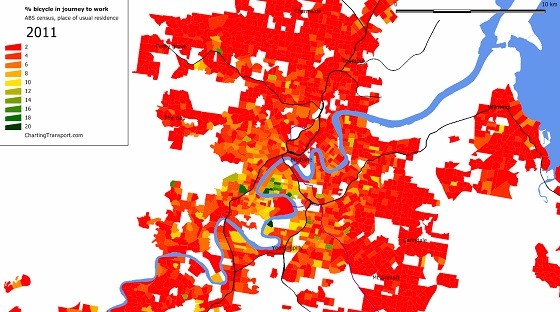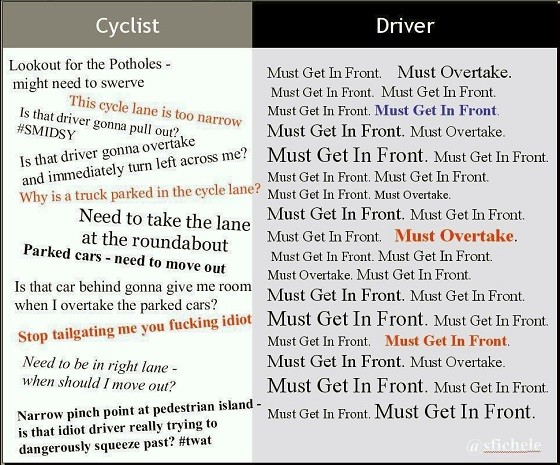
Qld’s Jane Fynes-Clinton is clearly fed up with cyclists. She set out her gripes in an opinion piece published in the Courier Mail yesterday (Look out for others before peddling your political agenda).
The key one is that cyclists take up space, both on roads where they cycle in bunches, and in coffee shops where they leave “no room for non-sweaty civilians”. Some of them are also “loud and obnoxious”; perceive the road as their own; and “ride on roads and paths like they own them.”
Moreover, they “don’t play nice”. They ignore red lights and they wear lycra.
The get-up is part of what gets to me – all that Lycra. But as a friend described it, for weekend wheelers it is akin to getting kitted up in helmet, pads, box and regulation whites for a game of backyard cricket.
What seems to especially annoy her are cyclists “who bay for blood at the mere whiff of criticism”. Their defensiveness, she says, is “often harsh and swift”.
Despite all the anti-cyclist invective, she covers her backside toward the end of the article by acknowledging that cycling is growing vigorously and provides important benefits both for riders and the wider community.
When you boil it all down though, Ms Fynes-Clinton is unhappy because cyclists use roads, wear lycra and behave as if they actually have rights. Worse, they’re actively seeking political change so they can use roads without getting killed!
Although the article is clearly labelled as opinion, the Courier Mail doesn’t bother to tell us anything about Ms Fynes-Clinton. It’s a distinctive name, though. As well as being a columnist for the Courier Mail, it appears she’s also a lecturer in journalism at the University of the Sunshine Coast.
My initial reaction was a desire to point out that cyclists have a legal right to use the roads; that the delay cyclists impose on motorists is trivial; and that ignoring red lights causes no harm to motorists. And what cyclists choose to wear is their own business (most don’t wear lycra).
But I suspect that wouldn’t even register with Ms Fynes-Clinton or her readers. This sort of article is about vile prejudice, not even-handed analysis; it’s like going back to the Qld of Joh Bjelke-Petersen.
Anyone who beats up on cyclists in the media for trivial reasons like taking up space in coffee shops shouldn’t expect to be taken seriously.
And yet there’s an important message here. It reminds us that there’re sections of the community that simply don’t accept the legitimacy of cycling on roads. They think roads are exclusively for motorised vehicles and cyclists are an inconvenience (see Are cyclists a ‘mere obstacles’ to motorists?).
I suspect there’re deeper conflicts here too. The fixation of critics on lycra suggests that cyclists represent a set of values and a way of life that is anathema to a large part of the population.
It might be that some motorists, when they see a cyclist, don’t see an individual who’s vulnerable and warrants special care and consideration. Rather, they see the cyclist merely as an impersonal symbol of everything they detest. If so, that’s not a relationship that’s good for either party, least of all the cyclist.
Although lycra is the most visible symbol, I think there’re many who resent all cyclists as much for what they are, or appear to represent, as for what they do. Riding a Euro-style sit-up might generate as much hatred as lycra and carbon.
Yet cyclists who ride in bunches on roads aren’t about to stop doing it, any more than they’re likely to stop wearing lycra. And just like motorists, there’ll always be plenty of cyclists who ignore the road rules when they’re confident they can get away with it. That’s not going to change.
More dedicated cycling infrastructure will help reduce the scope for conflict. But that’s only plausible in the longer term. What’s needed now is a strong statement from governments and community leaders that cyclists are legitimate and valued road users.
That can happen partly by highly visible changes to the law (e.g. > one metre overtaking rule) but mostly it needs a huge increase in enforcement. It also needs leadership; I’d like to see a coalition of opinion leaders drawn from politics, business, sport, popular culture, etc, lead a highly visible public campaign aimed at normalising cycling in Australia.









Crikey is committed to hosting lively discussions. Help us keep the conversation useful, interesting and welcoming. We aim to publish comments quickly in the interest of promoting robust conversation, but we’re a small team and we deploy filters to protect against legal risk. Occasionally your comment may be held up while we review, but we’re working as fast as we can to keep the conversation rolling.
The Crikey comment section is members-only content. Please subscribe to leave a comment.
The Crikey comment section is members-only content. Please login to leave a comment.